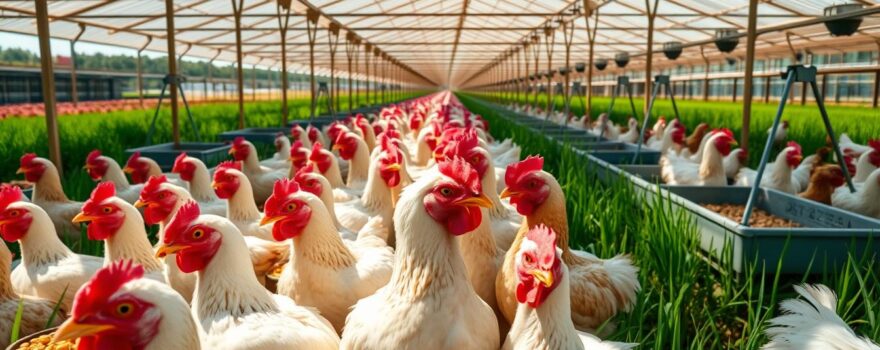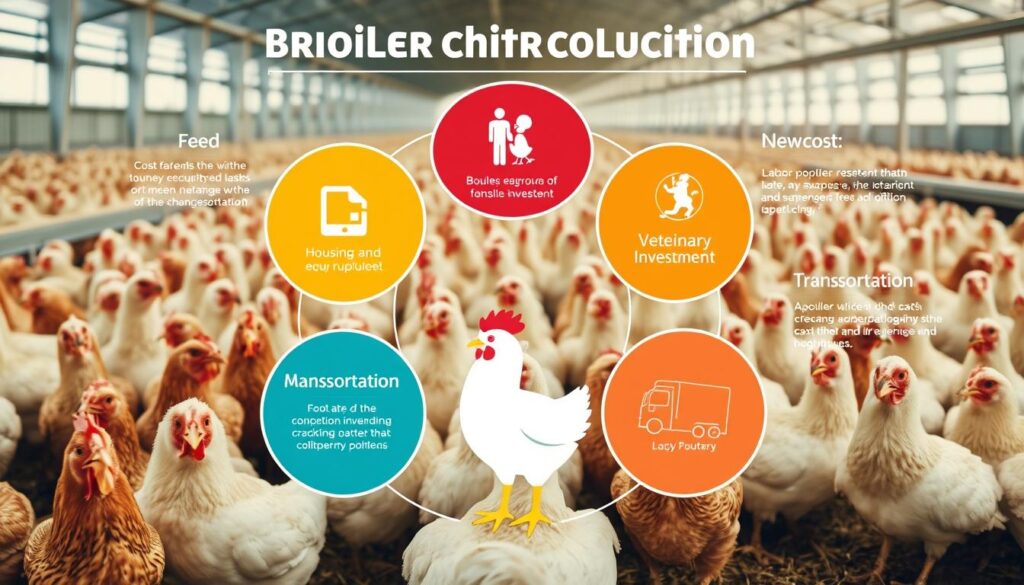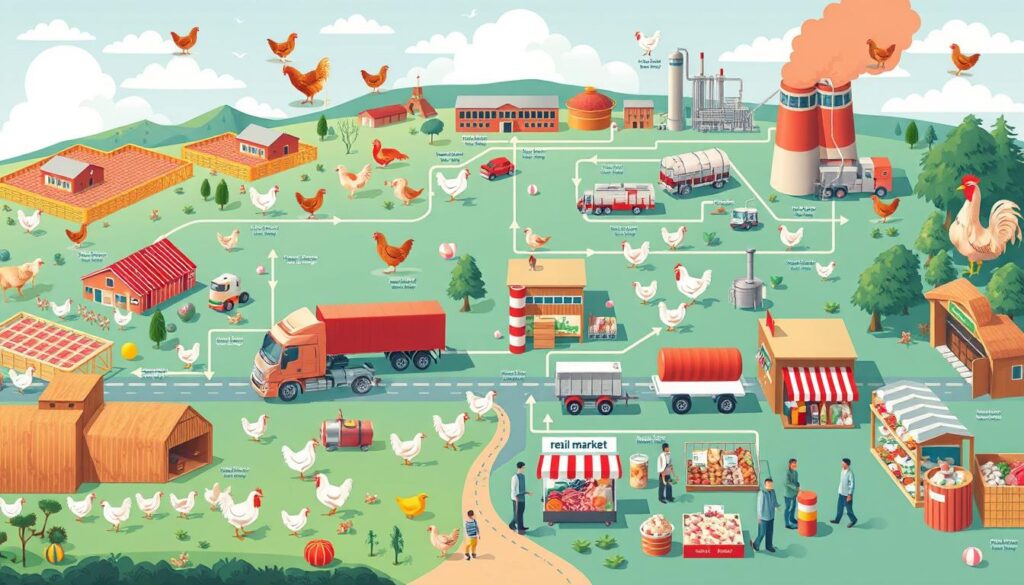
The global poultry industry relies heavily on broiler chickens. These birds are bred for fast growth and meat production. They are a key protein source around the world. This article explores how broiler chickens affect the poultry industry’s economy.
We look at their role in farming, the costs and profits, and the global meat market. The article also dives into the poultry supply chain, industry trends, and trade dynamics. It examines the sector’s competitiveness, productivity, and sustainability.
Key Takeaways
- Broiler chickens have a significant economic impact on the global poultry industry, accounting for a substantial portion of poultry production and consumption worldwide.
- The cost structure and profitability of broiler chicken farming are crucial factors in understanding the economics of the poultry industry.
- The global broiler meat market is a dynamic and rapidly growing segment, with market size and growth projections indicating its continued importance.
- Poultry supply chain analysis and industry trends and forecasts provide insights into the evolving landscape of the broiler chicken industry.
- Broiler chicken trade dynamics, sector competitiveness, and productivity metrics are essential considerations for understanding the global poultry industry.
Introduction to Broiler Chicken Production
Broiler chickens are key in the global poultry world. They are known for their fast meat production. Broiler chicken production focuses on raising these birds from start to finish. This ensures a steady supply of quality poultry.
Definition and Overview
Broiler chickens, or meat chickens, are raised for their quick growth and meat efficiency. The process includes choosing the right breed, age, and health. This helps the birds grow well and produce more meat.
Global Significance and Scale
The global broiler chicken industry plays a big role in the poultry world. It produces and consumes huge amounts of chicken. Millions of broiler chickens are raised every year to meet the growing demand for protein.
| Key Metric | Global Value |
|---|---|
| Annual Broiler Chicken Production | Over 100 billion birds |
| Global Broiler Meat Consumption | Approximately 100 million metric tons |
| Major Broiler Chicken Producing Countries | United States, Brazil, China, India, and European Union |
Understanding broiler chicken production and its global importance is crucial. It helps us see the industry’s economic role and future directions.
“Broiler chickens are the backbone of the global poultry industry, offering a reliable and affordable source of protein to consumers worldwide.”
Economic Impact of Broiler Chickens on the Global Poultry Industry
Broiler chickens are key to the global poultry industry’s economy. They have a big impact that goes beyond farms. These birds shape the financial world of poultry everywhere.
Broiler chickens are known for their fast growth and efficient meat production. They grow quickly and use less food, making meat cheaper and more available. This helps the poultry industry meet the world’s growing need for protein.
The broiler chicken industry also creates jobs and boosts local economies. Poultry farming and related jobs support millions, especially in poor countries. The industry’s effects spread, helping businesses like feed suppliers and equipment makers.
| Key Economic Indicators | Global Broiler Chicken Industry |
|---|---|
| Annual Production (million tons) | 125.8 |
| Global Market Value (USD billion) | $330.2 |
| Annual Growth Rate (%) | 4.2% |
| Employment (million jobs) | 58.1 |
Broiler chickens also help the whole poultry industry grow. They are the main meat source, making the whole chain more profitable. This includes hatcheries, feed suppliers, processors, and retailers.
“Broiler chickens are the economic engine that powers the global poultry industry, delivering affordable protein to consumers while generating substantial economic activity and employment opportunities worldwide.”
In summary, broiler chickens have a big impact on the global poultry industry. They are efficient in meat production and help the industry grow and create jobs. These birds are vital for the world’s food system, helping economies and ensuring food security.
Poultry Farming Economics
Poultry farming’s success depends on knowing the costs and profits of raising broiler chickens. These chickens are key to the global poultry industry. They help ensure food security and boost the economy.
Cost Structure and Profitability Analysis
Raising broiler chickens involves many costs, like feed, chick procurement, housing, and labor. Managing these costs well is key to making a profit. Things like feed efficiency, how many chickens die, and egg and chicken prices affect costs and profits.
- Feed costs are usually the biggest expense, making up to 70% of the total.
- Chick procurement, housing, and labor also play big roles in costs.
- Good disease management, efficient feeding, and better housing can cut costs and boost profits.
Doing a detailed cost-benefit analysis is vital for poultry farmers. It helps them make smart choices and stay ahead in the industry.
“Maximizing the profitability of broiler chicken production requires a deep understanding of the industry’s cost drivers and the ability to implement efficient management practices.”
By studying Poultry Farming Economics and Cost Structure and Profitability Analysis of Broiler Chicken Production, farmers can make better decisions. This helps them work more efficiently, increase production, and stay competitive in the poultry sector.

Broiler Chicken Production Costs
The costs of raising broiler chickens are key to the poultry industry’s success. These costs include feed, housing, and vet care. They greatly affect how much money broiler chicken farms make.
Feed is a big expense for broiler chicken farming. Chickens need a mix of grains, proteins, and supplements to grow fast. Feed costs can be up to 70% of all expenses, making it the biggest cost for farmers.
Labor is also a big cost. Farms need people to feed, clean, and check the birds’ health. Labor costs change based on where you are, local laws, and how automated the farm is.
Chickens need good housing to be happy and healthy. Building and keeping these places up, including systems for heat, cool air, and air flow, costs a lot.
Veterinary expenses are another big part of the costs. This includes keeping birds healthy with medicine and care. Keeping the birds healthy is key to making money and avoiding losses.
To make more money, farmers must watch these costs closely. They look for ways to work better, waste less, and use new technology.
“Efficient management of production costs is the key to sustaining a profitable broiler chicken operation in the global poultry market.”
Global Broiler Meat Market
The global broiler meat market is key in the poultry industry. It meets the growing need for affordable, nutritious protein. With the world’s population increasing, finding efficient, sustainable food production is crucial. Broiler chickens are at the center of this effort for both producers and consumers.
Market Size and Growth Projections
Industry analysts predict steady growth for the Global Broiler Meat Market. The market size is expected to hit impressive numbers. This growth is driven by rising incomes, changing diets, and modern farming adoption.
- The Global Broiler Meat Market is set to grow at a CAGR of around 4% from 2022 to 2030.
- By 2030, the global broiler meat market is expected to exceed $350 billion.
- Asia-Pacific, North America, and Latin America are leading in market expansion and broiler meat consumption.
This growth highlights the broiler meat industry’s role in meeting global protein demands. As the market evolves, it’s essential for producers, policymakers, and consumers to collaborate. They must ensure a sustainable, efficient broiler meat supply chain for the growing population.
“The broiler meat industry is a vital component of the global food system, providing a reliable and accessible source of protein to millions of people worldwide.”
Poultry Supply Chain Analysis
The poultry supply chain is a complex system that’s key to the global Poultry Supply Chain Analysis. It includes many stages, from production to distribution and consumption. Each stage has its own challenges and needs. Knowing how the supply chain works is vital for the broiler chicken industry’s success and sustainability.
At the core of the supply chain is the production stage. Farmers and producers work hard to raise healthy, quality broiler chickens. This involves using efficient farming methods, keeping chickens in clean environments, and working with reliable poultry suppliers. Good supply chain management helps get chickens to processing facilities on time and at a low cost.
| Stage | Key Factors | Challenges |
|---|---|---|
| Production |
|
|
| Processing |
|
|
| Distribution |
|
|
| Retail and Consumption |
|
|
The efficiency and strength of the Poultry Supply Chain Analysis are key to meeting global demand for poultry. Understanding the supply chain’s complexities helps the industry improve operations, reduce risks, and stay competitive.

“Efficient supply chain management is the backbone of a thriving poultry industry, enabling producers to deliver high-quality products to consumers in a timely and cost-effective manner.”
Broiler Industry Trends and Forecasts
The broiler chicken industry is changing fast, thanks to new technologies and practices. As more people want chicken, companies are using smart solutions. These help make production better, more efficient, and kinder to the planet.
Emerging Technologies and Innovations in Broiler Chicken Production
Advanced tech is a big deal in the broiler world. Precision farming uses IoT sensors and data to watch over chickens and their environment. This lets farmers make better choices and raise healthier birds.
Automation and robotics are making broiler work easier. Machines handle feeding and processing, freeing up humans to focus on other tasks. This makes work safer and more efficient.
Genetic engineering has brought better chicken breeds to the market. These birds eat less, get sick less, and grow faster. This means farmers can produce more without harming the environment or breaking the bank.
Broiler farms are also going green. They’re using clean energy, managing waste, and saving water. This helps reduce their impact on the planet and supports a greener food system.
Experts predict big changes in the broiler chicken industry. New tech and smart farming will lead to growth and change in the coming years.
Broiler Chicken Trade Dynamics
The global broiler chicken market is always changing. Countries trade a lot to meet the growing demand for chicken. It’s important to understand the trade dynamics and who the major players are.
Major Exporting and Importing Countries of Broiler Chicken
The United States, Brazil, and the European Union lead in exporting broiler chickens. Together, they make up over 80% of the global trade. Countries like China, Saudi Arabia, Mexico, and Japan import a lot of chicken to meet their needs.
Many things affect the broiler chicken trade. These include production costs, tariffs, and rules. Countries with low costs and good trade deals do well in the market.
| Top Broiler Chicken Exporting Countries | Top Broiler Chicken Importing Countries |
|---|---|
| 1. United States | 1. China |
| 2. Brazil | 2. Saudi Arabia |
| 3. European Union | 3. Mexico |
| 4. Thailand | 4. Japan |
| 5. Argentina | 5. United Kingdom |
By watching the trade dynamics and the big players, the industry can make smart choices. This helps them stay ahead in the changing global market.
Poultry Sector Competitiveness
The poultry industry, especially the broiler chicken sector, is vital in the global food system. Its ability to compete well is crucial for a steady and affordable protein supply. Productivity, efficiency, and market position play big roles in this.
Productivity and Efficiency
New technologies in breeding, feeding, and housing have boosted broiler chicken production. Now, broilers grow faster and have better feed conversion, leading to lower costs and higher profits for farmers.
Market Positioning
The poultry industry has positioned itself well to meet the world’s growing protein demand. Broiler meat is cheaper than other proteins, making it more accessible. The industry also keeps up with consumer wants, like organic and antibiotic-free options, which helps it stay competitive.
| Key Factors Driving Poultry Sector Competitiveness | Impact |
|---|---|
| Productivity Enhancements | Faster growth rates, higher feed conversion ratios, and reduced mortality |
| Technological Advancements | Improved breeding, feeding, and housing practices |
| Cost-Effective Production | Lower production costs and higher profit margins for poultry farmers |
| Adaptability to Consumer Trends | Expansion into organic and antibiotic-free poultry products |
The poultry sector’s competitiveness, thanks to productivity gains, efficiency, and smart market moves, has made it a global leader. This has ensured affordable broiler meat is widely available.
Broiler Chicken Productivity Metrics
In the broiler chicken industry, productivity metrics are key. They help understand if the business is profitable and performing well. Metrics like feed conversion ratio, growth rate, and carcass yield give insights into efficiency and profit.
The feed conversion ratio shows how well chickens use feed to gain weight. A lower ratio means better feed use, leading to lower costs and higher profits for producers.
Broiler growth rate is also important. It shows how fast chickens grow. Faster-growing chickens reach market weight quicker, saving time and resources. This boosts the industry’s productivity and growth.
Carcass yield is another critical metric. It measures how much meat is produced from each bird. A higher yield means more meat for sale, which improves financial results for producers.
| Productivity Metric | Industry Benchmark | Impact on Profitability |
|---|---|---|
| Feed Conversion Ratio | 1.5 – 1.7 | Lower feed costs, higher profit margins |
| Growth Rate | 50-60 grams per day | Reduced production time, enhanced scalability |
| Carcass Yield | 70-75% | More saleable meat, improved financial performance |
By focusing on these broiler chicken productivity metrics, the industry can make better decisions. This leads to more efficient operations and keeps them competitive in the global market.
Poultry Industry Sustainability
The poultry industry is making big steps towards being more sustainable. Broiler chickens are at the heart of these efforts. Producers are using eco-friendly methods to cut down on environmental harm. They aim to keep costs low and meet social needs too.
Using resources wisely is a big part of being sustainable. The industry is saving water and feed through new methods. For example, better watering systems and recycling have cut down water use. Also, new ways of making feed have made it more efficient, using less feed for more meat.
The industry is also working to reduce its carbon footprint. It’s using solar and wind power, and making poultry facilities more energy-efficient. These actions help the planet and make the industry more stable financially over time.